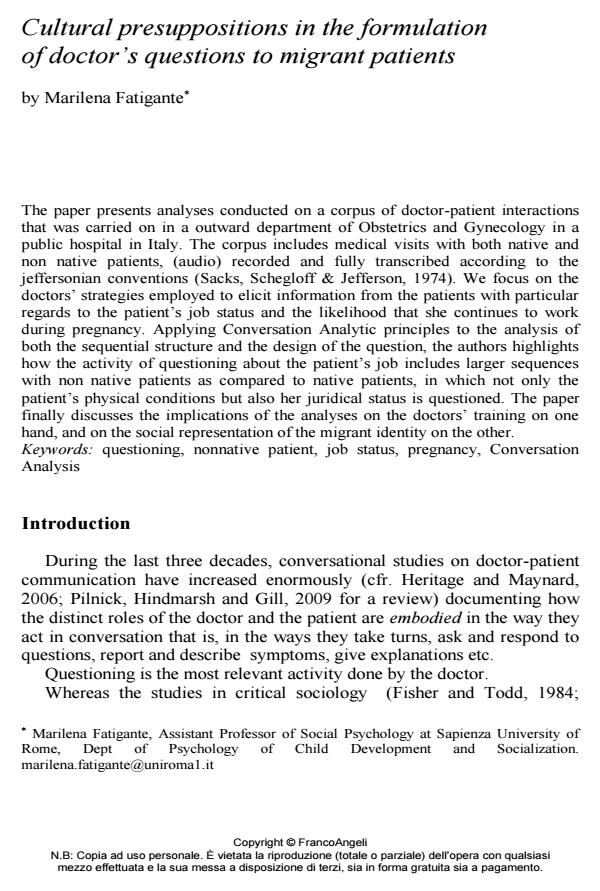Cultural presuppositions in the formulation of doctor’s questions to migrant patients
Journal title SALUTE E SOCIETÀ
Author/s Marilena Fatigante
Publishing Year 2013 Issue 2013/1EN
Language English Pages 19 P. 48-66 File size 389 KB
DOI 10.3280/SES2013-001005EN
DOI is like a bar code for intellectual property: to have more infomation
click here
Below, you can see the article first page
If you want to buy this article in PDF format, you can do it, following the instructions to buy download credits

FrancoAngeli is member of Publishers International Linking Association, Inc (PILA), a not-for-profit association which run the CrossRef service enabling links to and from online scholarly content.
The paper presents analyses conducted on a corpus of doctor-patient interactions that was carried on in a outward department of Obstetrics and Gynecology in a public hospital in Italy. The corpus includes medical visits with both native and non native patients, (audio) recorded and fully transcribed according to the jeffersonian conventions (Sacks, Schegloff & Jefferson, 1974). We focus on the doctors’ strategies employed to elicit information from the patients with particular regards to the patient’s job status and the likelihood that she continues to work during pregnancy. Applying Conversation Analytic principles to the analysis of both the sequential structure and the design of the question, the authors highlights how the activity of questioning about the patient’s job includes larger sequences with non native patients as compared to native patients, in which not only the patient’s physical conditions but also her juridical status is questioned. The paper finally discusses the implications of the analyses on the doctors’ training on one hand, and on the social representation of the migrant identity on the other.
Keywords: Questioning, nonnative patient, job status, pregnancy, Conversation Analysis
- Pilnick A., Hindmarsh J. and Gill V. (2009). Beyond 'doctor and patient': Developments in the study of healthcare interactions. Sociology of Health and Illness 31, 6: 787-802 DOI: 10.1111/j.1467-9566.2009.01194.x
- Pomerantz A.M. (1984). Agreeing and Disagreeing with Assessments: Some Features of Preferred/Dispreferred Turn Shapes. In: Atkinson P. and Heritage J., editors, Structures of Social Action. Cambridge: Cambridge University Press.
- Sacks H., Schegloff E.A. and Jefferson G. (1974). A symplest systematics for the organization of turn taking for conversation. Language, 50, 4: 696-735 DOI: 10.2307/412243
- Schegloff E.A. (1972). Sequencing in Conversational Openings. In: Gumperz J. and Hymes D., editors, Directions in Sociolinguistics: The Ethnography of Communication. New York: Holt Rinehart and Winston
- Sorjonen M.L., Raevarra L. Haakana M., Tammi T., and Perakyla A. (2006). Lifestyle Discussions in Medical Interviews. In: Heritage J. and Maynard D., editors, Communication in Medical Care: Interaction between Primary Care Physicians and Patients, New York: Cambridge University Press, 340–78 DOI: 10.1017/CBO9780511607172.014
- Stivers T., Heritage J. (2001). Breaking the sequential mold: Answering “more than the question” during comprehensive history taking. Text, 21, 1-2: 151-185 DOI: 10.1177/019027250707000410
- Stivers T., Majid A. (2007). Questioning children: Interactional evidence ofimplicit bias in medical interviews. Social Psychology Quarterly, 70, 4: 424- 441.
- Todd A. D. (1989). Intimate adversaries: Cultural conflicts between doctors and women patients. Philadelphia: University of Pennsylvania Press
- West C. (1984). Routine Complications: Troubles with Talk Between Doctors and Patients. Bloomington: Indiana University Press
- Boyd E., Heritage J. (2006). Taking the Patient's Medical History: Questioning During Comprehensive History Taking. In: Heritage J. and Maynard D., editors, Communication in Medical Care: Interactions between Primary Care Physicians and Patients. Cambridge: Cambridge University Press DOI: 10.1017/CBO9780511607172.008
- Byrne P., Long B. (1976). Doctors Talking to Patients. London: DHSS
- Drew P., Heritage J., editors (1992). Talk at work. Cambridge, England: Cambridge University Press
- Fasulo A. (2009). Domande che cominciano per ‘ma’ e per ‘e’. ‘L’epistemica debole’ della conversazione. In: Fatigante M., Mariottini L. e Sciubba M.E., editors, Lingua e Società. Saggi in onore di Franca Orletti. Roma: FrancoAngeli
- Fisher S., Todd A.D., editors, (1986). Discourse and institutional authority: Medicine, Education and Law. Norwood, NJ: Ablex.
- Haakana M. (2001). Laughter as a patient's resource: Dealing with delicate aspects of medical interaction. Text, 21, 1-2: 187-219, DOI: 10.1080/08351813.2011.544221
- Heath C. (1992). The delivery and reception of diagnosis in the general practice consultation. In: Drew P. and Heritage J., editors, Talk at Work. Cambridge: Cambridge University Press
- Heritage J., Raymond G. (in press). Navigating epistemic landscape: Acquiescence, agency and resistance in responses to polar questions. In: deRuiter J. P., editors, Questions: Formal, Functional and Interactional Perspectives. Cambridge: Cambridge University Press
- Heritage J. (2010). Questioning in Medicine. In: Freed A. and Ehrlich S., editors, "Why Do You Ask?": The Function of Questions in Institutional Discourse, New York: Oxford University Press, 42-68.
- Heritage J., Maynard D. (2006). Problems and prospects in the study of doctorpatient interaction: 30 years of research in primary care. Annual Review of Sociology. 32: 351-374 DOI: 10.1146/annurev.soc.32.082905.093959
- Heritage J. (1984). A Change-of-State Token and Aspects of its Sequential Placement. In: Atkinson P. and Heritage J., editors, Structures of Social Action. Cambridge: Cambridge University Press
- Jefferson G. (1989). Preliminary Notes on a Possible Metric which Provides for a ‘Standard Maximum’ Silence of Approximately one Second in Conversation. In: Roger D., and Bull P., editors, Conversation. An Interdisciplinary Perspective. Clevedon: Multilingual Matters
- Linell P., Luckmann T. (1991). Asymmetries in dialogue: some conceptual preliminaries. In: Marková I., and Foppa K., editors, Asymmetries in Dialogue. Hemel Hempstead: Harvester Wheatsheaf, 1-20
- Mishler E. G. (1984). The discourse of medicine: dialectics of medical interviews. Norwood, N.J.: Ablex Pub. Corp
- Orletti F. (2000). La conversazione diseguale. Roma: Carocci
- Parsons T. (1951). The Social System. New York: The Free Press
Marilena Fatigante, Cultural presuppositions in the formulation of doctor’s questions to migrant patients in "SALUTE E SOCIETÀ" 1EN/2013, pp 48-66, DOI: 10.3280/SES2013-001005EN